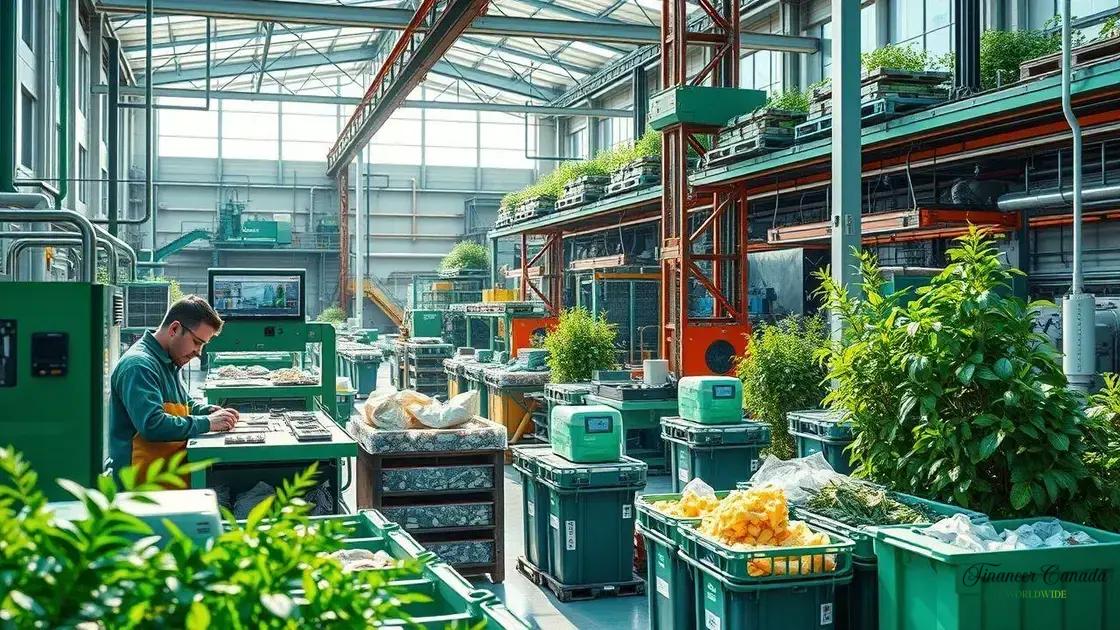How the circular economy is reshaping industries for better

The circular economy is a sustainable model that focuses on reducing waste, reusing resources, and recycling materials to create a closed-loop system, benefiting both the environment and businesses.
The concept of how the circular economy is reshaping industries may seem complex at first, but it’s fundamentally about sustainability and innovation. Ever thought about how businesses can thrive while being eco-friendly? Let’s dive into this transformative approach.
Understanding the circular economy concept
The circular economy is an innovative concept that challenges the traditional linear economy model. Instead of the usual ‘take, make, dispose’ approach, the circular economy focuses on sustainability and efficiency.
This system emphasizes the importance of reusing and recycling materials, thereby minimizing waste. As businesses and individuals adopt these practices, they can contribute to a healthier planet.
Key Principles of Circular Economy
Understanding the core principles of the circular economy is crucial for its successful implementation. These principles include:
- Design for Longevity: Products should be created to last longer and be easy to repair.
- Embrace Renewable Resources: Utilize sustainable materials that do not deplete resources.
- Prioritize Reuse and Repair: Encourage users to repair and repurpose items instead of discarding them.
- Recycle Efficiently: Promote effective recycling processes that reclaim materials for future use.
By adopting these principles, industries can generate less waste and reduce their environmental impact. Companies are now more focused on creating value from waste materials rather than viewing them as disposable items.
Benefits of Circular Economy
The advantages of transitioning to a circular economy are numerous. First, it can lead to substantial cost savings for businesses. By reusing materials and optimizing resource usage, companies can lower their operational expenses. Additionally, the circular model fosters innovation as it encourages the development of new business models.
Moreover, consumers are increasingly interested in sustainable practices. Companies that promote a circular economy can enhance their brand reputation and connect with eco-conscious customers. Many industries are now realizing that sustainability isn’t just beneficial for the environment, it also drives profitability.
Key principles driving the circular economy

The key principles driving the circular economy are fundamental for understanding how this model operates. These principles emphasize sustainability and innovation, which are vital in today’s world.
One major principle is design for longevity. This means products should be made to last, allowing for easy repairs and upgrades. When companies embrace this principle, they reduce waste and improve their product lifecycles.
Core Principles of the Circular Economy
Another important principle is utilizing renewable resources. This involves choosing materials that are sustainable and can be replenished naturally. By prioritizing these resources, businesses can minimize their environmental footprint.
- Promote Recycling: Efficient recycling processes help reclaim materials and reduce waste.
- Encourage Reuse: Products should be designed so that they can be reused or repurposed, extending their useful life.
- Support Local Economies: Sourcing materials locally can decrease transportation emissions and bolster local businesses.
As we explore these principles, it becomes clear that each one contributes to a larger goal of reducing environmental impact and creating sustainable practices. Furthermore, adopting these principles can enhance a company’s brand image, attracting environmentally conscious consumers.
Ultimately, the key principles of the circular economy encourage a shift in how we think about resources. By integrating these concepts, industries not only foster innovation but also pave the way for a more sustainable future.
Benefits for businesses adopting circular practices
Businesses adopting circular practices stand to gain numerous advantages. Embracing the circular economy not only supports sustainability but also enhances profitability and efficiency.
One significant benefit is cost reduction. By reusing materials and optimizing resource usage, companies can lower their production costs. This can significantly impact their bottom line over time.
Improved Brand Image
Another valuable advantage is the enhancement of a company’s brand image. Consumers are increasingly drawn to businesses that prioritize sustainability. By adopting circular practices, companies can attract eco-conscious customers who value environmentally friendly options.
- Better Customer Loyalty: A commitment to sustainability fosters customer loyalty as consumers feel good about supporting responsible brands.
- Increased Innovation: The shift to circular practices encourages creativity and innovation in product design and services.
- Diverse Revenue Streams: Circular businesses can create new services like product take-back programs, generating additional revenue.
As companies experience these benefits, they become part of a larger movement towards sustainability. Furthermore, transitioning to a circular model can help businesses mitigate risks related to resource scarcity and regulatory pressures.
In this evolving landscape, adopting circular practices is becoming essential. It aligns with the increasing demand for sustainable solutions, allowing companies to thrive while making a positive impact on the environment.
Real-world examples of circular economy success

Examining real-world examples of circular economy success reveals how effective these practices can be. Many companies are leading the charge by transforming their operations to minimize waste and enhance sustainability.
For instance, the **clothing brand Patagonia** has made a significant impact by promoting repair and reuse. Their Worn Wear program encourages customers to repair their gear instead of discarding it, extending the life of their products and reducing waste.
Innovative Companies Leading the Way
Another notable example is **IKEA**, which is shifting towards a circular business model. They are focusing on using renewable and recycled materials in their products. Additionally, IKEA is developing a take-back program for their furniture, allowing customers to return old items for recycling or refurbishment.
- Unilever: This consumer goods giant is committed to making all of its plastic packaging recyclable or reusable by 2025.
- Interface: A flooring company that uses recycled materials to create carpets and is working towards a zero environmental footprint.
- Google: They aim to run their data centers on renewable energy and use recycled materials in their products.
These companies exemplify how circular economy principles can not only benefit the environment but also drive business innovation. By focusing on sustainability, these businesses are changing how consumers view their products and practices.
Real-world examples highlight that transitioning to a circular economy can lead to tangible benefits, not only for companies but also for the planet.
Future trends in the circular economy
Looking at the future trends in the circular economy reveals exciting possibilities for sustainability and innovation. As industries evolve, circular practices are expected to gain even more momentum.
One emerging trend is the increasing use of technology to enhance circular practices. Innovations such as blockchain can help track materials throughout their lifecycle, ensuring transparency and efficiency. This technology allows companies to verify sustainable sourcing and recycling processes.
Shifts in Consumer Behavior
Additionally, consumer preferences are shifting towards more sustainable products. People are now more aware of their impact on the environment and are choosing brands that prioritize eco-friendly practices. This trend is motivating businesses to adopt circular economy principles to meet growing demand.
- Sustainable Materials: Companies are exploring renewable and biodegradable materials to minimize environmental impact.
- Product as a Service: More businesses are offering services instead of products, allowing users to rent or lease items rather than owning them outright.
- Collaborative Consumption: The sharing economy is growing, with platforms facilitating the exchange of goods and services, reducing waste.
As circular economy principles become more mainstream, businesses are likely to form partnerships that promote resource sharing and sustainability. This collaboration can lead to more innovative solutions and greater efficiency across industries.
Overall, the future of the circular economy looks promising, with advances in technology and changing consumer preferences driving significant change. Companies that adapt to these trends will find new opportunities for growth and sustainability.
FAQ – Frequently Asked Questions about Circular Economy
What is the circular economy?
The circular economy is a model that emphasizes reusing, recycling, and reducing waste, aiming to create a more sustainable system.
How can businesses benefit from adopting circular practices?
Businesses can reduce costs, improve brand reputation, and attract eco-conscious consumers by implementing circular practices.
What are some examples of companies using circular economy principles?
Companies like Patagonia, IKEA, and Unilever are successfully adopting circular economy practices to enhance sustainability.
What future trends are expected in the circular economy?
Increased use of technology, shifts in consumer behavior towards sustainability, and collaboration between businesses are anticipated trends.





